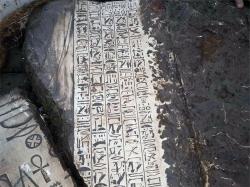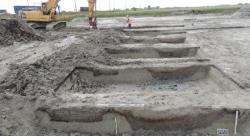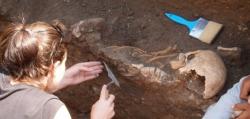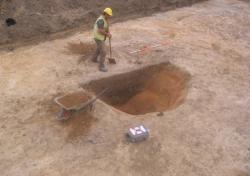INSTITUT SUPERIEUR D'ANTHROPOLOGIE
INSTITUTE OF ANTHROPOLOGY
ONLINE COURSES / COURS A DISTANCE
WINTER TERM : JANUARY 2015
REGISTER NOW
EGYPTE – 
 Al-Badrasheen - Seven residents of a Giza district have been arrested after they illegally excavated the area beneath their home and found the remains of an ancient Egyptian temple. The huge limestone blocks, engraved with hieroglyphic texts, date from the reign of the New Kingdom's King Tuthmose III, and were found in the Hod Zeleikha area of Al-Badrasheen district. Antiquities Minister Mamdouh El-Damaty said that the unearthed blocks are genuine and belong to a huge temple from the reign of King Tuthmose III. Seven reliefs and two marble columns were unearthed along with a huge red-granite armless colossus of a seated person, El-Damaty. The items have been brought to the Saqqara site for restoration and further study, the minister said, adding that the Hod Zeleikha area has now been declared an archeological site and under the control of the ministry in order carry out more surveys nearby and unearth more of the temple.
Al-Badrasheen - Seven residents of a Giza district have been arrested after they illegally excavated the area beneath their home and found the remains of an ancient Egyptian temple. The huge limestone blocks, engraved with hieroglyphic texts, date from the reign of the New Kingdom's King Tuthmose III, and were found in the Hod Zeleikha area of Al-Badrasheen district. Antiquities Minister Mamdouh El-Damaty said that the unearthed blocks are genuine and belong to a huge temple from the reign of King Tuthmose III. Seven reliefs and two marble columns were unearthed along with a huge red-granite armless colossus of a seated person, El-Damaty. The items have been brought to the Saqqara site for restoration and further study, the minister said, adding that the Hod Zeleikha area has now been declared an archeological site and under the control of the ministry in order carry out more surveys nearby and unearth more of the temple.
http://english.ahram.org.eg/NewsContent/9/40/114274/Heritage/Ancient-Egypt/Giza-men-arrested-after-digging-up-ancient-temple-.aspx
FRANCE –  Marck - Au printemps, une équipe d’archéologues se sont penchés sur le passé de la Turquerie. Cette action fait suite à une opération de diagnostic réalisée par le service archéologique de Cap-Calaisis en juin et juillet 2012 . Le bureau d'études Éveha a mené ses fouilles sur un hectare de la ZAC de La Turquerie de mi-avril à début juin. Les objectifs de la fouille étaient de mieux connaître les occupations humaines du littoral, en documentant l'organisation spatiale et l'utilisation des structures antiques nous renseignant sur l'exploitation des ressources maritimes à l'époque romaine. Elles s'inscrivent dans la continuité de l'étude des sites datant du Moyen Âge fouillés par le service archéologique de Cap-Calaisis . Marck se situe à la frange occidentale de la Plaine Maritime Flamande et le site occupe un contexte géologique particulier, sur l'arrière du cordon dunaire et sur une zone de marais intérieur, profondément modifié par les apports successifs de sédiments marins et des alluvions déposés dans l'estran. Les découvertes d'objets archéologiques ont été nombreuses. Au total, le produit de ces fouilles a permis de remplir pas moins de 75 caisses. Il s'agit essentiellement de céramiques, d'os d'animaux, de coquillages et d'objets en pierre. Six tombes d'époque romaine ont également été découvertes. L'une correspond à une inhumation en pleine terre et les cinq autres à la pratique de la crémation. Les conditions particulières de conservation en milieu humide ont également permis la découverte de nombreux restes organiques, tel que des pièces de bois et une vannerie. L'essentiel de l'activité du site à l'époque romaine se tourne autour de la collecte et de la préparation des coquillages : coques, moules et huîtres et de l'extraction d'argile probablement pour la production des pots en céramique qui servent à cuire les fruits de mer. L'exploitation opportuniste des ressources maritimes est également documentée par la découverte d'une écaille de tortue de mer et de vertèbres de cétacés. Les recherches se poursuivent en laboratoire afin de caractériser la nature et la chronologie du site, par le traitement du mobilier archéologique collecté, par les études céramologiques, lithiques, paléoenvironnementales, géomorphologiques, archéozoologiques et études complémentaires.
Marck - Au printemps, une équipe d’archéologues se sont penchés sur le passé de la Turquerie. Cette action fait suite à une opération de diagnostic réalisée par le service archéologique de Cap-Calaisis en juin et juillet 2012 . Le bureau d'études Éveha a mené ses fouilles sur un hectare de la ZAC de La Turquerie de mi-avril à début juin. Les objectifs de la fouille étaient de mieux connaître les occupations humaines du littoral, en documentant l'organisation spatiale et l'utilisation des structures antiques nous renseignant sur l'exploitation des ressources maritimes à l'époque romaine. Elles s'inscrivent dans la continuité de l'étude des sites datant du Moyen Âge fouillés par le service archéologique de Cap-Calaisis . Marck se situe à la frange occidentale de la Plaine Maritime Flamande et le site occupe un contexte géologique particulier, sur l'arrière du cordon dunaire et sur une zone de marais intérieur, profondément modifié par les apports successifs de sédiments marins et des alluvions déposés dans l'estran. Les découvertes d'objets archéologiques ont été nombreuses. Au total, le produit de ces fouilles a permis de remplir pas moins de 75 caisses. Il s'agit essentiellement de céramiques, d'os d'animaux, de coquillages et d'objets en pierre. Six tombes d'époque romaine ont également été découvertes. L'une correspond à une inhumation en pleine terre et les cinq autres à la pratique de la crémation. Les conditions particulières de conservation en milieu humide ont également permis la découverte de nombreux restes organiques, tel que des pièces de bois et une vannerie. L'essentiel de l'activité du site à l'époque romaine se tourne autour de la collecte et de la préparation des coquillages : coques, moules et huîtres et de l'extraction d'argile probablement pour la production des pots en céramique qui servent à cuire les fruits de mer. L'exploitation opportuniste des ressources maritimes est également documentée par la découverte d'une écaille de tortue de mer et de vertèbres de cétacés. Les recherches se poursuivent en laboratoire afin de caractériser la nature et la chronologie du site, par le traitement du mobilier archéologique collecté, par les études céramologiques, lithiques, paléoenvironnementales, géomorphologiques, archéozoologiques et études complémentaires.
http://www.nordlittoral.fr/accueil/les-archeologues-se-sont-penches-sur-le-passe-de-la-turquerie-ia0b0n150737
INDONESIE - Liyangan- Liyangan archaeological site on the slope of Mount Sindoro in Temanggung regency, Central Java, has again proven its position as home to one of main archeological findings in Indonesia after archeologists from the Yogyakarta Archeology Agency found the fossilized remnants of staple foods, comprising maize and rice, still inside a bamboo basket at the site. The archeologists said the finding indicated that Indonesia had long been part of an international agriculture network because maize was not endemic to Java and at the site they had also found many artifacts from other countries, especially China. Head of the Yogyakarta Archeology Agency, Siswanto, said the findings proved that agricultural produce had been one of the primary commodities traded between Indonesia and its trade partners. “The finding is also crucial to help us trace the history of food cultivation and technology in Indonesia, especially in Java,” said Siswanto, who spoke during the opening of the 2014 General Soedirman University (Unsoed) Fair in Purwokerto, recently. During the excavation, the archeologists reportedly found fossilized maize and grains of rice in Liyangan, Purbosari village, Ngadirejo district, which is located 7.5 kilometers from the peak of Mt. Sindoro. It was believed that the fossilized staple food grew between the eighth and tenth centuries, during the era of the ancient Mataram kingdom. Siswanto said the excavation took place on a plot of land approximately one hectare in size. At the location, the archeologists also unearthed a temple and 40 ancient Chinese vases dating back to the Tang Dynasty. Liyangan is a residential settlement in Temanggung at which archeologists had previously found many important archeological objects.
http://www.thejakartapost.com/news/2014/10/29/fossilized-maize-rice-found-temanggung.html
BULGARIE –  Voden - The skeleton of a child whose legs had been bound after death in an anti-vampire ritual has been found by archaeologists at a dig at the Voden Fortress in the Rhodopes, according to the head of the Assenovgrad Historical Museum, Ivan Doukov. Three “vampire” skeletons were found this autumn during the archaeological dig at the fortress, near a village that dates back to Roman and ultimately Thracian times. Local media quoted Doukov as saying that in the case of one of the other bodies, the legs were tied after death, and in the other case, the feet were severed. So-called “vampire” burials in Bulgaria, involving remains dating back to medieval times, have excited considerable interest. Earlier in October, at the Perperikon site, the skeleton of a man was found with a ploughshare driven through its ribcage. The skeleton was said to date from the 13th century CE. Driving a ploughshare through the ribcage was among rituals, like tying the legs or placing stones on the chest, intended to prevent the dead becoming undead. The Assenovgrad museum’s Doukov said that medieval people were very superstitious. “They believed that if someone in his lifetime was a bad person or if he died under unusual circumstances, he could become a vampire and harass his living relatives.” Doukov said that such superstitions still exist in the Rhodope Mountains and northwestern Bulgaria. They are very similar to medieval beliefs about vampires and other malicious beings. In August, Doukov announced that 30 graves dating from the 30th century, most of them of children, as well as a Thracian burial from the fifth to sixth century BCE had been uncovered at the Voden fortress above the town. At a news conference earlier this year, Perperikon archaeological chief Professor Nikolai Ovcharov said that the highest incidence of graves where indications of anti-vampire rituals were found was in the Rila and Rhodope mountain areas. These were places where Christianity was in a weaker position against enduring pagan traditions, he said. Such rituals continued at least into the time of Ottoman rule in Bulgaria, he said.
Voden - The skeleton of a child whose legs had been bound after death in an anti-vampire ritual has been found by archaeologists at a dig at the Voden Fortress in the Rhodopes, according to the head of the Assenovgrad Historical Museum, Ivan Doukov. Three “vampire” skeletons were found this autumn during the archaeological dig at the fortress, near a village that dates back to Roman and ultimately Thracian times. Local media quoted Doukov as saying that in the case of one of the other bodies, the legs were tied after death, and in the other case, the feet were severed. So-called “vampire” burials in Bulgaria, involving remains dating back to medieval times, have excited considerable interest. Earlier in October, at the Perperikon site, the skeleton of a man was found with a ploughshare driven through its ribcage. The skeleton was said to date from the 13th century CE. Driving a ploughshare through the ribcage was among rituals, like tying the legs or placing stones on the chest, intended to prevent the dead becoming undead. The Assenovgrad museum’s Doukov said that medieval people were very superstitious. “They believed that if someone in his lifetime was a bad person or if he died under unusual circumstances, he could become a vampire and harass his living relatives.” Doukov said that such superstitions still exist in the Rhodope Mountains and northwestern Bulgaria. They are very similar to medieval beliefs about vampires and other malicious beings. In August, Doukov announced that 30 graves dating from the 30th century, most of them of children, as well as a Thracian burial from the fifth to sixth century BCE had been uncovered at the Voden fortress above the town. At a news conference earlier this year, Perperikon archaeological chief Professor Nikolai Ovcharov said that the highest incidence of graves where indications of anti-vampire rituals were found was in the Rila and Rhodope mountain areas. These were places where Christianity was in a weaker position against enduring pagan traditions, he said. Such rituals continued at least into the time of Ottoman rule in Bulgaria, he said.
http://sofiaglobe.com/2014/10/30/bulgarian-archaeologists-find-skeleton-of-child-buried-with-anti-vampire-ritual/
ROYAUME UNI –  Rossington - Up to 20 people once lived at this Rossington farmstead, growing crops, keeping cattle and drawing water from holes they dug in the boggy ground. That was 19 centuries ago. The secrets of this Roman-era settlement have been revealed by Sheffield company Wessex Archaeology which has just finished a two-year study of the area Teams of up to 15 Wessex staff discovered foundation stones, ditches, four waterholes, Romano-British pottery and a cremation site. ‘Cropmarks’ in the landscape - lines, circles and squares of strong plant growth - indicate an extensive system of fields. A deeper excavation was undertaken once the site of the farmstead building was found. Andrew Norton, manager of the Sheffield office, said: “We’re not digging up temples every day. On this site we are looking at normal folk. “The second century AD was a period of relative calm in this area and the main concerns of these people would have been their crops and livestock. “Peas are grown there today and it’s very interesting to see how little things have changed, apart from the technology - and even then much farm machinery was horse drawn up to World War Two.” Pieces of a leather Roman boot were found nearby. The mixed agricultural economy was possibly organised from nearby villas, such as those found to the south-east at Stancil and to the west at Loversall and Wadworth. Parrot’s Corner was once home to a Roman Fort, while Doncaster was a Roman town.
Rossington - Up to 20 people once lived at this Rossington farmstead, growing crops, keeping cattle and drawing water from holes they dug in the boggy ground. That was 19 centuries ago. The secrets of this Roman-era settlement have been revealed by Sheffield company Wessex Archaeology which has just finished a two-year study of the area Teams of up to 15 Wessex staff discovered foundation stones, ditches, four waterholes, Romano-British pottery and a cremation site. ‘Cropmarks’ in the landscape - lines, circles and squares of strong plant growth - indicate an extensive system of fields. A deeper excavation was undertaken once the site of the farmstead building was found. Andrew Norton, manager of the Sheffield office, said: “We’re not digging up temples every day. On this site we are looking at normal folk. “The second century AD was a period of relative calm in this area and the main concerns of these people would have been their crops and livestock. “Peas are grown there today and it’s very interesting to see how little things have changed, apart from the technology - and even then much farm machinery was horse drawn up to World War Two.” Pieces of a leather Roman boot were found nearby. The mixed agricultural economy was possibly organised from nearby villas, such as those found to the south-east at Stancil and to the west at Loversall and Wadworth. Parrot’s Corner was once home to a Roman Fort, while Doncaster was a Roman town.
http://www.thestar.co.uk/news/business/digging-deep-to-find-a-host-of-roman-remains-1-6922031
CHINE – Kangle - Chinese archaeologists said they have discovered a large paleolithic site that dates back 10,000 to 30,000 years in northeast China's Heilongjiang Province. The ruins, covering more than 40,000 square meters, were found in a mountainous area in Kangle Village, Muleng City, said Ni Chunye, director of the city's administration of cultural heritage, on Wednesday. The site was identified as belonging to the Old Stone Age earlier this month. A total of 136 stone tools in various shapes were collected from the surface of the site. The findings and geological features indicated the site belongs to the Upper Paleolithic period, Ni said. Of the unearthed large paleolithic sites in China, the Muleng site is furthest east, providing important evidence for research on human development, according to Li Youqian, an expert with the provincial institute of archaeology.
http://www.china.org.cn/china/2014-10/29/content_33906065.htm?
USA –  Fort Monroe - In the years following the start of a new comprehensive survey in 1996, archaeologists have turned up more than 20 potential sites at Fort Monroe — with nearly a dozen boasting features that made them eligible for the National Register of Historic Places, Eaton said. Among them is a prehistoric site found some 7 feet below today's surface, while another trash deposit from the first Hygeia Hotel didn't crop up until the very end of a long trail of clues that led excavators 5 feet beneath ground level. "The problem with Fort Monroe is that things are very complicated below the surface," Eaton said, describing the difficulties of probing a landscape that was continuously raised and expanded by Army engineers over the course of nearly 200 years. And as Calonico learned after starting work at the fort as a contract archaeologist in 2009, some of those deposits from Monroe's long history can provide dramatic windows into its past. In 2012, she helped excavate a "fantastic" cache of 140 well-preserved glass bottles hidden beneath the backyard of a house near the Chamberlin. That same year archaeologists discovered the concrete platforms and wooden timbers of a lost gun battery originally built in 1897 — plus an array of 900 related artifacts that did not include a single munition.
Fort Monroe - In the years following the start of a new comprehensive survey in 1996, archaeologists have turned up more than 20 potential sites at Fort Monroe — with nearly a dozen boasting features that made them eligible for the National Register of Historic Places, Eaton said. Among them is a prehistoric site found some 7 feet below today's surface, while another trash deposit from the first Hygeia Hotel didn't crop up until the very end of a long trail of clues that led excavators 5 feet beneath ground level. "The problem with Fort Monroe is that things are very complicated below the surface," Eaton said, describing the difficulties of probing a landscape that was continuously raised and expanded by Army engineers over the course of nearly 200 years. And as Calonico learned after starting work at the fort as a contract archaeologist in 2009, some of those deposits from Monroe's long history can provide dramatic windows into its past. In 2012, she helped excavate a "fantastic" cache of 140 well-preserved glass bottles hidden beneath the backyard of a house near the Chamberlin. That same year archaeologists discovered the concrete platforms and wooden timbers of a lost gun battery originally built in 1897 — plus an array of 900 related artifacts that did not include a single munition.
http://www.dailypress.com/features/history/dp-nws-fort-monroe-archaeology-20141029-story.html